Introduction
"In the ocean, [bioluminescence] is the rule rather than the exception" - Edith Widder 1
What is bioluminescence?
Production of light by a living organism through a chemical reaction is termed as bioluminescence. This production of light is termed as “cold light” as less than 20% of the produced light results in thermal radiation. 2 Bioluminescence is the predominant form of illumination in marine environments, and is essentially absent in the freshwater sources. 3
The phenomenon of bioluminescence is observed in marine organisms such as invertebrates, fungi, bacteria, etc. 4
Mechanism of Bioluminescence
The chemical reaction resulting in the phenomenon of bioluminescence occurs mainly due to the presence of an enzyme known as Luciferase. The light-emitting pigment Luciferin reacts with Luciferase in the presence of oxygen to produce Oxyluciferin, resulting in the production of light. 5
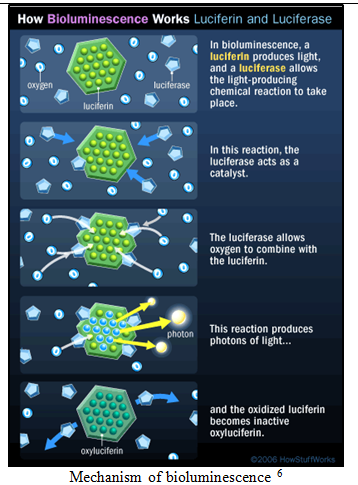
Different types of Luciferin 7
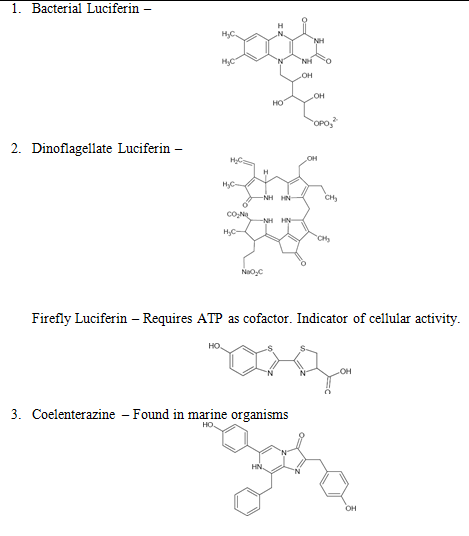
Production of different types of luceferin 8
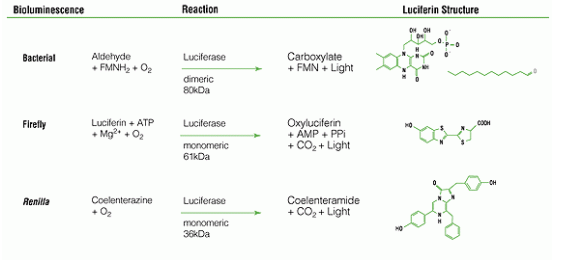
Bioluminescent Organisms
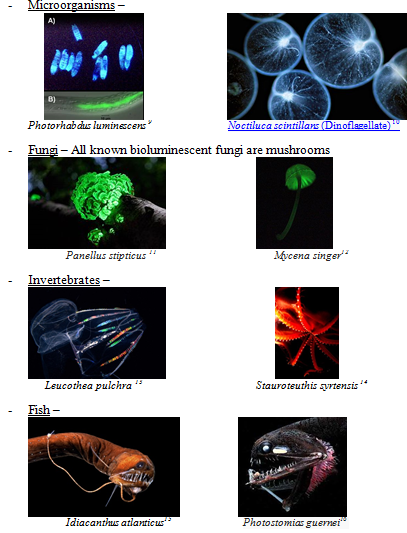
Colours produced
Factors affecting colour production during bioluminescence �"
1. Luciferin
2. Luciferase structures
3. Accessory luminophores
4. Optical biological filters 19
| Colour | Reason for Effect produced 19 |
| Blue | Shorter wavelength reaching furthest in sea water. Photoproteins emitting blue light such as Aequorin (present in Aequorea victoria), requiring calcium ions |
| Green | Aequorin + Green Fluorescent protein (GFP) not requiring calcium ions |
| Yellow | Produced similar to green colour with the exception of Yellow Fluorescent Protein (YFP) �" genetic mutant of GFP |
| Red | Very uncommon as large wavelength cannot be detected by most species. Light initially produced as blue light, and then absorbed by a fluorescent pigment which re-emits it as red light |
| Violet | Photoprotein producing blue colour has undergone mutation resulting in violet colour |

Glowee �" The Biolighting System
Glowee is a biolighting living system which requires no electricity, whilst producing minimal amount of light pollution and CO2 emission. 20
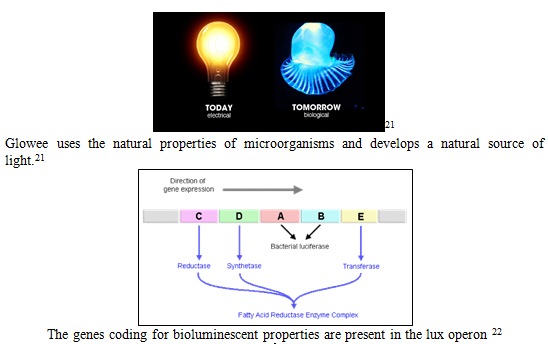
These genes are isolated from bioluminescent bacteria existing in a symbiotic relationship with squids. Using genetic engineering, these genes are then inserted in non-bioluminescent non-toxic non-pathogenic bacteria. These engineered bacteria are introduced in a suitable nutrient medium for their growth, propagation, and light production. 21
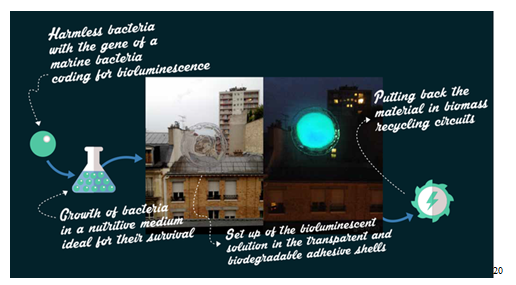
Glowee is transparent during the day and luminescent at night. It is made up of an organic biodegradable, transparent shell that sticks to glazed surfaces. This shell also contains the biological and bioluminescent solution. 20
Microorganisms involved
Currently, Glowee uses the bioluminescent bacterium Aliivibrio fischeri which exists in a symbiotic relationship with the Hawaiian bobtail squid Euprymna scolopes. 23
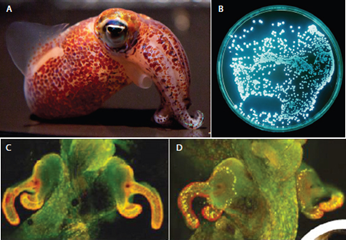
A. Aliivibrio fischeri isolated on nutrient medium Luminescent Agar
B. and D. Bioluminescent activity of Aliivibrio fischeri present on Euprymna scolopes 24
Reasons for developing biological source of light 21
Glowee is an alternate source of energy. This aims to �"
1. Reduce the 19% share of electric consumption on account of electric lighting
2. Providing a non-polluting environmentally friendly source of illumination
Facts about Bioluminescence
1. Human beings exhibit bioluminescence but the amount of light produced is 1000 times weaker than the normal detection levels of the human eye. This bioluminescence is thought to occur as a result of free radical production (by-product of cellular metabolic reaction). 25
2. Bioluminescence produced by the cookiecutter shark prevents shadow formation, preventing detection by prey on the lower surface. 26
3. The principal uses of bioluminescence in organisms are �" Communication, Food location, Prey Attraction, Camouflage, Self-Defence. 26
Conclusion
Bioluminescence is one of the most interesting and visually appealing natural phenomena occurring in various living organisms. This phenomenon serves purposes such as communication, camouflage, etc.
Biolighting utilizes bioluminescent bacteria to produce a potential alternate energy source which is non-polluting as well as environmentally-friendly.
References
1. Edith Widder quote: In the ocean, [bioluminescence] is the rule rather than the exception. Available from http://www.azquotes.com/quote/557622 [Accessed 8th May 2016]
2. Bioluminescence �" National Geographic Society. Available from http://education.nationalgeographic.org/encyclopedia/bioluminescence/ [Accessed 8th May 2016]
3. The Bioluminescence Webpage. Available from http://biolum.eemb.ucsb.edu/ [Accessed 8th May 2016]
4. Bioluminescence �" Wikipedia, The Free Encyclopedia. Available from https://en.wikipedia.org/wiki/Bioluminescence [Accessed 8th May 2016]
5. BASIC BIOLUMINESCENCE. Available from http://photobiology.info/LeeBasicBiolum.html [Accessed 8th May 2016]
6. Bioluminescence in the Ocean by Isabelle Abrams on Prezi. Available from https://prezi.com/s6dx7zbdpazj/bioluminescence-in-the-ocean/ [Accessed 8th May 2016]
7. Bioluminescence. Available from http://www.quantum-immortal.net/physics/biolum.php [Accessed 8th May 2016]
8. 1/a. Reaction entre luciferine et luciferase. Available from http://tpe-bioluminescence.e-monsite.com/pages/1-a-reaction-entre-luciferine-et-luciferase.html [Accessed 8th May 2016]
9. Photorhabdus luminescens �" MicrobeWiki. Available from https://microbewiki.kenyon.edu/index.php/Photorhabdus_luminescens [Accessed 8th May 2016]
10. Maya protest sea sparkle. Available from http://www.turbosquid.com/3d-models/maya-protist-sea-sparkle/573712 [Accessed 8th May 2016]
11. Panellus stipticus �" Wikipedia, The Free Encyclopedia. Available from https://en.wikipedia.org/wiki/Panellus_stipticus#Bioluminescence [Accessed 8th May 2016]
12. List of bioluminescent fungi �" Wikipedia, The Free Encyclopedia. Available from https://en.wikipedia.org/wiki/List_of_bioluminescent_fungi [Accessed 8th May 2016]
13. Diverdave Photo Keywords: Leucothea pulchra. Available from https://diverdave.smugmug.com/keyword/leucothea%20pulchra/ [Accessed 8th May 2016]
14. The Invertebrates | Deep Sea Bioluminescence. Available from http://2010.extrememarine.org.uk/bioluminescence/the-organisms/the-invertebrates/index.html [Accessed 8th May 2016]
15. Terrifying Deep Sea Creatures | Discovery Channel Australia. Available from http://www.discoverychannel.com.au/images/terrifying-deep-sea-creatures/ [Accessed 8th May 2016]
16. Photostomias �" Wikipedia, The Free Encyclopedia. Available from https://en.wikipedia.org/wiki/Photostomias [Accessed 8th May 2016]
17. Lohlimer George, Lohlimer Becky. Fireflies: Let Your Love Light Shine; How do fireflies light up attracting fireflies garden | The Old Farmer’s Almanac. Available from https://www.almanac.com/content/fireflies-let-your-love-light-shine [Accessed 8th May 2016]
18. Fireworks in the Night. Available from http://www.fishchannel.com/fish-magazines/freshwater-and-marine-aquarium/2007-march/fireworks-in-the-night.aspx [Accessed 8th May 2016]
19. Different Colours? | The Bizarre World of Bioluminescence. Available from http://2014.extrememarine.org.uk/suprememarine/different-colours/index.html [Accessed 8th May 2016]
20. Glowee, the living biolighting system �" Ulele. Available from https://www.ulule.com/glowee/ [Accessed 8th May 2016]
21. Glowee, enlightened by the sea. Available from http://www.glowee.eu/ [Accessed 8th May 2016]
22. Meighen E.A., Lin L Y-C. BACTERIAL BIOLUMINESCENCE; Biochemistry and Molecular Biology, 25th January 2009. Available from http://photobiology.info/Lin.html [Accessed 8th May 2016]
23. Chang, Lulu. Let Bacteria Provide Your Light With Glowee’s Bioluminescence; Bioluminescent Bacteria Power Glowee’s Lights | Digital Trends, 24th March 2016. Available from http://www.digitaltrends.com/home/glowee-bacteria/ [Accessed 8th May 2016]
24. Institute of Medicine. Workshop Overview. The Social Biology of Microbial Communities: Workshop Summary. 2012. p. 9. doi:10.17226/13500. Available from http://www.nap.edu/read/13500/chapter/2#9 [Accessed 8th May 2016]
25. Bentley, Elliot. Humans Glow in the Dark. The Guardian. 17th July 2009. Available from https://www.theguardian.com/science/blog/2009/jul/17/human-bioluminescence [Accessed 8th May 2016]
26. Bioluminescence: The Living Light Phenomenon | New Infographic. Available from http://newinfographic.com/science/nature/bioluminescence-living-light-phenomenon/ [Accessed 8th May 2016]
About Author / Additional Info:
I am a post-graduate in Biochemistry from the University of Mumbai